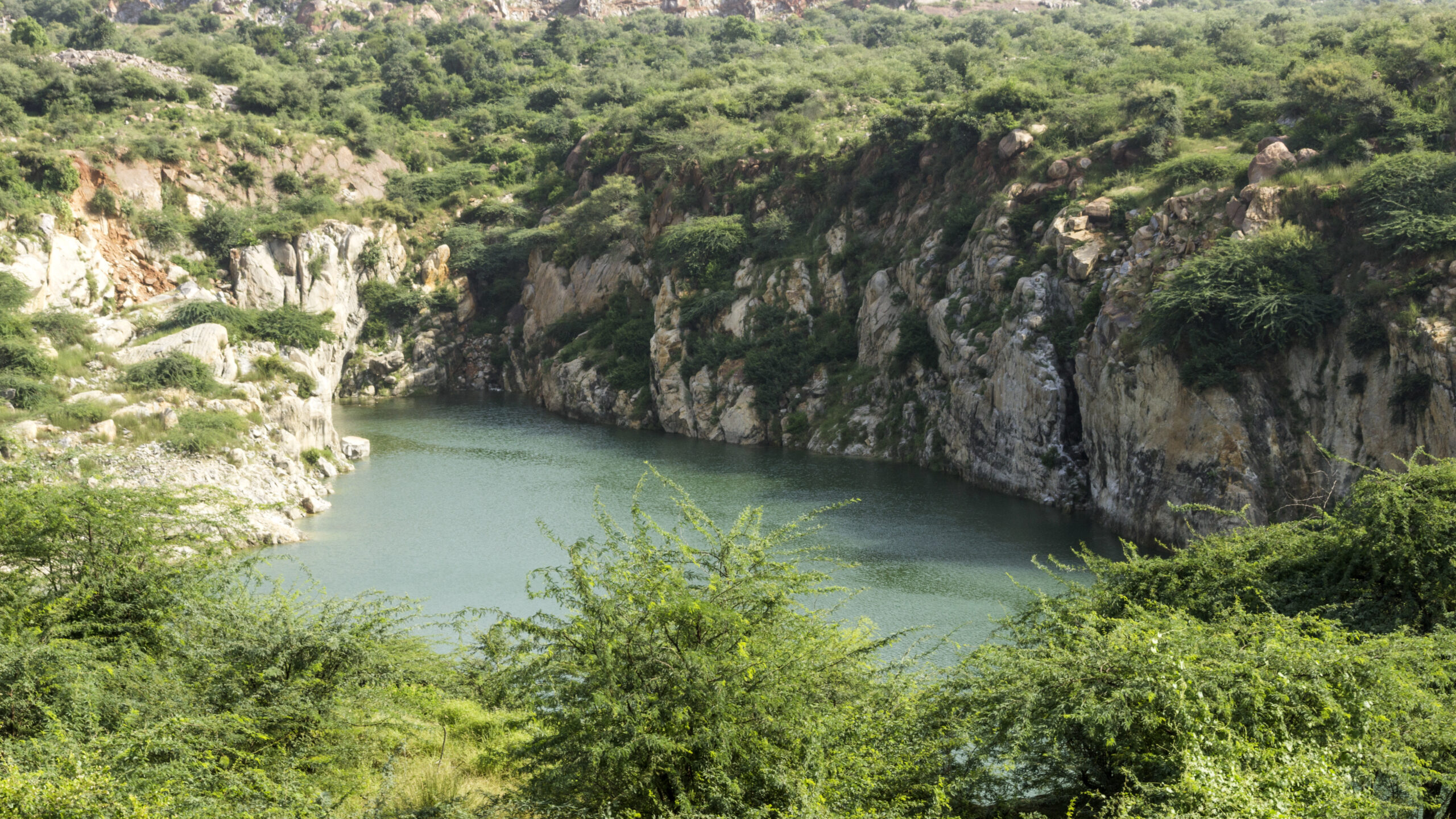
The Asola Bhatti Wildlife Sanctuary, situated between Delhi and Faridabad is a beautiful forest area with a number of lakes in it. (Photo: Getty)
Covering over 6,874 acres on the southern edge of the city, the Asola Bhatti wildlife sanctuary expands over the Delhi-Haryana border. The ridge consists of an immense amount of quartzite deposits which are used as construction material. The area was declared as a wildlife sanctuary in 1986, and subsequently, more regions were added to it in 1991. The illegal mining industry thrived on the extraction of its resources until the late 90s.
The issue of unregulated mining was discussed when seven quarry workers lost their lives, leading to complete halt of the whole mining process.
Located in the northern limit of Aravalli Hill range, the geomorphology of rocks of Aravalli is mainly igneous in nature. These rocks are compact and used for various mineral extractions. The sand formation is a process of stone corrosion through weathering and seasonal rainfall over the years. After the declaration of wildlife sanctuary, mining activity was stopped and the deep mines can be seen in the sanctuary. The famous blue lake of Asola is one of the deepest sand mines of the sanctuary.
“First and foremost step the department took is building a boundary wall around the entire area, so that the entry into the area is restricted”, says Mandeep Mittal IFS, Dy. Conservator of Forests (South Division) Jurisdiction.
Along with mining, cutting down trees and cattle grazing was also stopped to protect the sanctuary. Afforestation was one of the methods adopted to restore the sanctuary from the after effects of mining. Intensive patrolling has been initiated to prevent unauthorised access.
Mining aftereffects
“This landscape is now under the healing process, with the active intervention by Delhi Forest Department”, says Sumit Dookia, Assistant Professor at University School of Environment Management.
“Currently, the mining sites and their surrounding areas are under ecosystem restoration process. This will take years to gain its lost ecological wealth, but after active efforts from the Forest Department, we can observe the good signs in biodiversity value”, he adds.
“When we cut the earth’s surface vertically, we can see layers of different soils. The upper layers are more organic and fertile in nature, rich in nitrogen, phosphorus and potassium with very small granule size”, he explains.
The deeper you go, he continues, you find bigger and porous particles with less organic matter. At the time of mining, they remove the top soil and excavate the economically-beneficial sand.
Mining leaves a double impact on landscape: one is removal of top fertile soil layer, and deposition of unfertile sand over it, known as “overburden” in the mining language; then mining changes the topography of landscape, turning the water course as well as clearance of all vegetation from and around the mining sites. These disurbed sites then attract invasive plants to grow and survive.
Restoration process
Over the period of time, the Forest Department has planted a lot of native trees. “Last year, the department planted around 50,000-60,000 trees, and this year we planted almost 2 lakh trees”, adds Mittal.
Speaking on the same line, Dookia says, “This landscape should not be treated like any urban garden, where fancy and flowering trees are planted for aesthetic value. Here, plantations should be done for biodiversity.”
In an attempt to restore the sanctuary, Prosopis Juliflora, an invasive shrub/tree has been suppressed naturally by replacing it with native plants. To prevent soil erosion, 250 check dams and several streams have been built.
Asola Bhatti is home to more than 193 species of birds, 80 species of butterflies and other animals like black buck, blue bull, nilgai bull, leopards among others.
“When the area was protected, the wildlife also flourished. Leopards have become a permanent resident of the area. We have hyenas, golden jackals, chitals”, continues Mittal.
Speaking about the scope of the process, Dookia says “Restoration is a slow and gradual process and it will take at least 20-30 years to come back to its glorious biodiversity. But the current changes give us hope to achieve this.”
Last month Chief Minister Aravind Kejriwal visited the sanctuary and directed the officials to turn the mining pits to reservoirs to tackle the water logging issue. Asked about the current status of the plan, Mittal assures that it is already in place.
Inhabitants in the sanctuary
Before Asola Bhatti was declared a wildlife sanctuary, a majority of people who came as refugees during India-Pakistan partition settled in Bagirnath village in Bhatti mines.
The resettlement case of the inhabitants are still under court proceedings. While the environmentalists find human inhabitants as a threat to the sanctuary, the whole life of more than 4,500 families are in dilemma.
“There were a couple of areas in which water inside the forest was going to the inhibition areas. We are in the process of building check dams for their purpose”, says Mittal.
According to the Forest Department, no fresh encroachments are entertained in the area.
The Forest Department is also trying to develop eco-tourism plans in the coming future, in consideration of protecting biodiversity.
For more stories that cover the ongoings of Delhi NCR, follow us on:
Instagram: https://www.instagram.com/thepatriot_in/
Twitter: https://twitter.com/Patriot_Delhi
Facebook: https://www.facebook.com/Thepatriotnewsindia
The four cases are linked to the land-for-jobs and IRCTC scam, which are being probed…
This was followed by the Delhi Development Authority (DDA), which addressed 4,804 of the 5,197…
These local stores stock thicker jackets, practical sweaters, and everyday layers that are designed for…
Veer Ahlawat’s final-round 67 sealed a three-shot win at the Rs 1 crore CIDCO Open…
OnePlus has launched the 15R smartphone and Pad Go 2 tablet in India, with prices…
Nearly 2,800 Delhi vehicles denied fuel on first day of 'No PUC, No Fuel' drive…